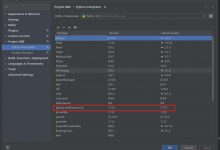1 系统IO与文件IO的比较
文件IO的响应速度更快,但是标准IO的吞吐量更大!
系统IO比文件IO多了一步写入stdio buffer的操作,可以参考下图

注意标准IO和文件IO不要混用,因为两者的文件指针指向的buf不一样,前者是std buf,后者是内核buf(file*里有),可以用如下两个函数进行转换:
int fileno(FILE *stream); 将指针转成文件描述符FILE *fdopen(int fd, const char *mode); 将文件描述符转成指针
2 文件操作
2.1 mode_t位图分析(16位)
关于mode_t类型,st_mode是一个16位的位图,用于表示文件类型,文件访问权限,以及特殊权限位
键入ls -l 查看文件状态,其中第一列为st_mode,其为16位的位图



实际16位如下所示,前四位表示文件类型,后九位表示文件权限
2.2 stat获取文件属性
int stat(const char *pathname, struct stat *statbuf);//返回statbufint fstat(int fd, struct stat *statbuf);int lstat(const char *pathname, struct stat *statbuf);lstat与stat区别在于,lstat函数遇到link文件,不会解析其源文件,只会解析其link文件本身,而stat会解析其源文件
struct stat结构体如下所示:
stat命令:
这里区分lstat与stat,如果入参为link类型,则stat描述的是符号链接链接的源文件,而lstat则描述符号链接文件
#include <stdlib.h>#include <stdio.h>#include <sys/types.h>#include <sys/stat.h>#include <unistd.h>int main(int argc, char** argv){int rs1,rs2;struct stat *statbuf1= (struct stat *)malloc(sizeof(struct stat));struct stat *statbuf2= (struct stat *)malloc(sizeof(struct stat));rs1 = stat(argv[1],statbuf1);rs2 = lstat(argv[1],statbuf2);if(rs1<0){perror(\"stat\");exit(1);}if(rs2<0){perror(\"lstat\");exit(1);}printf(\"no1 of %d\\n\",statbuf1->st_blocks);printf(\"no2 of %d\\n\",statbuf2->st_blocks);free(statbuf1);free(statbuf2);exit(0);}

2.3 umask
umask主要为了防止权限过松的文件
umask默认为0022,创建文件open,mkdir时,使用默认0666 & ~umask
也可以指定文件权限的位图,例如上例子open第三个参数,0600
mode_t umask(mode_t mask);
umask()将调用进程的文件权限创建掩码(umask)设置为mask & 0777(即:,只使用掩码的文件权限位),并返回之前的掩码值。
2.4 chmod
chmod可以更改权限,例如chmod 666 ./hellodup6, 更改成666权限

int chmod(const char *pathname, mode_t mode);int fchmod(int fd, mode_t mode);
2.5 目录创建和销毁
增加文件目录和删除文件目录
mkdir
NAMEmkdir, mkdirat - create a directorySYNOPSIS#include <sys/stat.h>#include <sys/types.h>int mkdir(const char *pathname, mode_t mode);
rmdir
NAMErmdir - delete a directorySYNOPSIS#include <unistd.h>int rmdir(const char *pathname); //删除空目录DESCRIPTIONrmdir() deletes a directory, which must be empty.
2.6 更改当前工作路径,获取
chdir() = cd
NAMEchdir, fchdir - change working directorySYNOPSIS#include <unistd.h>int chdir(const char *path);int fchdir(int fd);DESCRIPTIONchdir() changes the current working directory of the calling process to the directory specified in path.fchdir() is identical to chdir(); the only difference is that the directory is given as an open file descriptor.
获取当前路径,getcwd()= pwd
NAMEgetcwd, getwd, get_current_dir_name - get current working directorySYNOPSIS#include <unistd.h>char *getcwd(char *buf, size_t size);输入参数buf为指定字符串,以及size长度,如果当前目录超过size,则报错。如果buf写NULL,则会自动malloc,需要free注意,成功时,buf为当前目录
使用getcwd与readdir,opendir,获取当前目录下所有文件
#include <stdio.h>#include <stdlib.h>#include <dirent.h>#include <errno.h>#include <unistd.h>#define BUFSIZE 50int main(int argc,char** argv){DIR* dir;struct dirent* sdir;char* pwd = NULL; //这里不能用char pwd[50]; pwd = getcwd(buf,BUFSIZE), 数组名是常量指针char buf[BUFSIZE];pwd = getcwd(buf,BUFSIZE); //如果是NULL,则会malloc,记得freeputs(buf);dir = opendir(pwd);if(dir == NULL){perror(\"dir\");exit(1);}while(1){sdir = readdir(dir);if((sdir == NULL)&&(errno!= 0)){perror(\"readdir\");exit(1);}else if(sdir == NULL)break;puts(sdir->d_name);}closedir(dir);exit(0);}

2.7 分析目录与读取目录
可以用glob函数,获取某个目录下(通配符)的所有文件。
glob函数,使用通配符pattern,来指定目录,其与int argc char** argv类似./glob ./*.c
glob申请了gl_pathv的内存,需要搭配globfree函数来销毁
typedef struct {size_t gl_pathc; /* Count of paths matched so far */char **gl_pathv; /* List of matched pathnames. */size_t gl_offs; /* Slots to reserve in gl_pathv. */} glob_t
这里注意,glob_t.gl_pathc≈argc ,glob_t.gl_pathv≈argv
#include <stdio.h>#include <stdlib.h>#include <glob.h>#define PAT \"./ *.c\"#define DIR \"./ *\" //为非隐藏,./.*为隐藏,这里不能用./来当做pattern参数int main(int argc,char** argv){glob_t globres,globdir;int revalue = glob(PAT,0,NULL,&globres);int rdvalue = glob(DIR,0,NULL,&globdir);if(revalue){printf(\"Errror code = %d\\n\",revalue);exit(1);}if(rdvalue){printf(\"Errror code = %d\\n\",rdvalue);exit(1);}for(int i=0;i<globres.gl_pathc;i++){printf(\"%s\\n\",globres.gl_pathv[i]);}puts(\"--------------------------------------\");for(int i=1;argv[i]!=NULL;i++){printf(\"%s\\n\",argv[i]);}puts(\"--------------------------------------\");for(int i=0;i<globdir.gl_pathc;i++){printf(\"%s\\n\",globdir.gl_pathv[i]);}globfree(revalue);globfree(rdvalue);exit(0);}

上述两种获得当前路径文件的方法,glob与readdir等函数,其实际可能是利用了dentry结构中的双向链表遍历,同一层dentry的子目录来获取
2.8 目录流操作函数
文件操作与目录操作类似,均
DIR *opendir(const char *name); //打开目录流DIR *fdopendir(int fd);struct dirent *readdir(DIR *dirp);int closedir(DIR *dirp);void rewinddir(DIR *dirp); //复位目录流,回到头部void seekdir(DIR *dirp, long loc); //设置目录流位置long telldir(DIR *dirp); //告诉目录流当前位置
这里分析下readdir函数:
struct dirent *readdir(DIR *dirp);返回值:正常为struct dirent *类型的指针,读到底为NULL(当errno不等于0时,在判断出错)struct dirent *类型如下所示:struct dirent {ino_t d_ino; /* Inode number */off_t d_off; /* Not an offset; see below 这里d_off的与telldir是一样的,目录文件指针的位置*/unsigned short d_reclen; /* Length of this record */unsigned char d_type; /* Type of file; not supportedby all filesystem types */char d_name[256]; /* Null-terminated filename 文件名*/};d_type有如下8种类型,其中7种为基础文件类型DT_BLK This is a block device.DT_CHR This is a character device.DT_DIR This is a directory.DT_FIFO This is a named pipe (FIFO).DT_LNK This is a symbolic link.DT_REG This is a regular file.DT_SOCK This is a UNIX domain socket.DT_UNKNOWN The file type could not be determined.
使用目录流操作函数来获取某目录下的所有文件,
#include <stdio.h>#include <stdlib.h>#include <dirent.h>#include <errno.h>int main(int argc,char** argv){DIR* dir;struct dirent* sdir;dir = opendir(argv[1]);if(dir == NULL){perror(\"dir\");exit(1);}while(1){sdir = readdir(dir); //持续读,有目录流指针定位if((sdir == NULL)&&(errno!= 0)){perror(\"readdir\");exit(1);}else if(sdir == NULL)break;puts(sdir->d_name);}closedir(dir);exit(0);}

2.9 口令文件与阴影文件操作
2.9.1 口令文件
通过vim /etc/passwd可以查看口令文件
这里字段解析如下所示
struct passwd *getpwnam(const char *name); 通过用户名访问,获得passwdstruct passwd *getpwuid(uid_t uid); 通过UID获得passwdThe passwd structure is defined in <pwd.h> as follows:struct passwd {char *pw_name; /* username */char *pw_passwd; /* user password */uid_t pw_uid; /* user ID */gid_t pw_gid; /* group ID */char *pw_gecos; /* user information */char *pw_dir; /* home directory */char *pw_shell; /* shell program */};
2.9.2 阴影文件
加密口令是单向加密的,不能反向解析出密码

函数分析1:
struct spwd *getspnam(const char *name); 通过用户名访问,获取spwd结构体struct spwd *getspent(void);struct spwd {char *sp_namp; /* Login name */char *sp_pwdp; /* Encrypted password */long sp_lstchg; /* Date of last change(measured in days since1970-01-01 00:00:00 +0000 (UTC)) */long sp_min; /* Min # of days between changes */long sp_max; /* Max # of days between changes */long sp_warn; /* # of days before password expiresto warn user to change it */long sp_inact; /* # of days after password expiresuntil account is disabled */long sp_expire; /* Date when account expires(measured in days since1970-01-01 00:00:00 +0000 (UTC)) */unsigned long sp_flag; /* Reserved */};
函数分析2:
char *getpass(const char *prompt); 不回返,获取密码char *crypt(const char *key, const char *salt); 通过key密码和salt,加密获得明文$id$salt$encrypted,这里会提取$id$salt$,其中id为加密方法!

加密方法有如下几种,crypt将Method的ID和salt和起来。
ID | Method─────────────────────────────────────────────────────────1 | MD52a | Blowfish (not in mainline glibc; added in some| Linux distributions)5 | SHA-256 (since glibc 2.7)6 | SHA-512 (since glibc 2.7)
例子分析,实现通过getspnam获取spwd,再crypt加密,与spwd第二个参数获取的明文比对,判断是否输入正确
#define _XOPEN_SOURCE#include <stdlib.h>#include <stdio.h>#include <unistd.h>#include <shadow.h>#include <string.h>#define PWSIZE 50int main(int argc, char** argv){char *pw;char *crt;struct spwd *newpd;int i;pw = getpass(\"input a password: \");puts(pw);newpd = getspnam(argv[1]);if(newpd == NULL){perror(\"getspnam\");exit(1);}crt = crypt(pw,newpd->sp_pwdp);puts(crt);if(crt == NULL){perror(\"crypt\");exit(1);}i = strcmp(newpd->sp_pwdp,crt);if(i == 0){puts(\"correct\");}exit(0);}
3 open函数
int open(const char *pathname, int flags);int open(const char *pathname, int flags, mode_t mode);
flags可以如下设置
mode可以如下设置

open(\"hellodup5\",O_RDWR|O_CREAT|O_TRUNC,0600);0600 = user read 400 + write 200 ,其他为0
其中前三个表示文件拥有者的权限,中间三个表示文件所属组拥有的权限,最后三个表示其他用户拥有的权限。
4 lseek函数(与空洞文件)
#include <unistd.h>off_t lseek( int filedes, off_t offset, int whence );
返回值:若成功则返回新的文件偏移量,若出错则返回-1。
- 按系统默认情况,当打开一个文件时,除非指定O_APPEND选项,否则该偏移量被设置为0。
- lseek仅将当前的文件偏移量记录在内核中,它并不引起任何I/O操作。然后,该偏移量用于下一个读或写操作。
- 文件偏移量可以大于文件的当前长度,在这种情况下,对该文件的下一次写将加长该文件,并在文件中构成一个空洞,文件中空洞均为0。
#include <stdio.h>#include <stdlib.h>#include <fcntl.h>#include <unistd.h>int main(int argc, char* argv[]){int fd;fd = open(argv[1],O_WRONLY|O_CREAT|O_TRUNC,0600);if(fd<0){perror(\"open()\");exit(1);}lseek(fd,5ll*1024ll*1024ll*1024ll-1ll,SEEK_SET);write(fd,\"\",1); //系统调用,导致lseek偏移的并非为空洞文件,直接cp,会导致Blocks为0,为空洞文件close(fd);exit(0);}

通过 cp操作后, 使用stat或者ls -l查看文件状态,发现其Blocks为0,因为cp发现其为空洞文件,则没有执行write操作

lseek = fseek + ftell , 先执行fseek,设置文件指针,后通过ftell获取文件指针
4 程序重定向(dup=duplication)
dup与dup2,fcntl,类似于echo “???”> PATH
int dup(int oldfd); //将oldfd的指针复制到当前可用的最小的int fcntl(int fd, F_DUPFD, arg ); //fcntl(fd,F_DUPFD,0) = dup(fd),注意,要大于等于arg的最小值Duplicate the file descriptor fd using the lowest-numberedavailable file descriptor greater than or equal to arg. This isdifferent from dup2(2), which uses exactly the file descriptorspecifiedint dup2(int oldfd, int newfd); //如果newfd已经打开,则close(newfd),再dup(oldfd),不再是最小的,而是newfd如果oldfd = newfd的话,则dup2什么都不会做,返回newfd
dup(dup使用时,可能是非原子,使用dup2代替可以)
例子1
#include <stdio.h>#include <stdlib.h>#include <sys/types.h>#include <sys/stat.h>#include <fcntl.h>#include <unistd.h>int main(){int fd;FILE* fp;//close(1);fd = open(\"hellodup5\",O_RDWR|O_CREAT|O_TRUNC,0600);// fp = fopen(\"hellodup1\",\"w+\");// fd = fileno(fp);if(fd<0){ perror(\"fopen\");exit(1);}close(1);dup(fd); //这两步可以用dup(fd,1)代替if(fd != 1)close(fd);printf(\"helloworld\\n\");exit(0);}
例子2
#include <stdio.h>#include <stdlib.h>#include <sys/types.h>#include <sys/stat.h>#include <fcntl.h>#include <unistd.h>int main(){int fd;FILE* fp;//close(1);fd = open(\"hellodup5\",O_RDWR|O_CREAT|O_TRUNC,0600);// fp = fopen(\"hellodup1\",\"w+\");// fd = fileno(fp);if(fd<0){ perror(\"fopen\");exit(1);}dup2(fd,1); //如果fd = 1,则dup2什么都不干if(fd != 1)close(fd); //则要判断fd是否为1,是1,则不closeprintf(\"helloworld\\n\");exit(0);}
dup2,指向性替换fd
#include <stdio.h>#include <stdlib.h>#include <unistd.h>#include <fcntl.h>int main(){FILE* fp;int fd;fp = fopen(\"helloworld\",\"w+\");if(fp==NULL){perror(\"fopen\");exit(1);}fd = fileno(fp);printf(\"fd = %d\\n\",fd);//close(2);int fdn = dup2(fd,2); //dup2是close(2),与dup(fd),的原子操作printf(\"???????\\n\");//fcntl(fd,F_DUPFD,1);for(int i=0;i<10; i++){fprintf(stderr,\"hello+\");}fflush(stderr);printf(\"end/n\");fclose(fp);exit(0);}
 爱站程序员基地
爱站程序员基地


